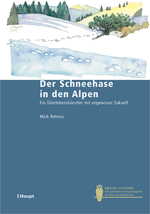
Abstract of book: «Der Schneehase in den Alpen. Ein Überlebenskünstler mit ungewisser Zukunft». Zürich, Bristol-Stiftung; Bern, Haupt. ISBN 978-3-258-07846-5
The mountain hare in the Alps: A survivor artist with an uncertain future
The mountain hare Lepus timidus (Linnaeus, 1758) occurs in isolated populations in the Alps at altitudes above 1300 m a.s.l. It is one of the smallest mammals in the Alpine environment to remain active year-round, and is especially well adapted to survive the winter “bottleneck”. To understand how mountain hares cope with harsh and rapidly changing environmental conditions in the Alps, I have summarized the available information about the biology and ecology of mountain hares and used findings from studies of other hare populations for its interpretation.
Tourism in the European Alps has developed rapidly over the last century, affecting wildlife throughout the region. The mountain hare has been especially affected by increased tourism because it is active year-round, but its physiological and behavioural reactions to tourism are still unknown. Results from measurements of the concentration of faecal glucocorticoid metabolites (GCM) in free-ranging mountain hares in areas that have either no, low, or high levels of tourism showed that GCM secretion is positively correlated with increased tourism. Such stress situations lead to changes in the behaviour and energy intake of mountain hare. Normally, hares remain hidden during the day and re-ingest their own pellets to meet their energy needs. Should a potential danger be detected, this energy intake is stopped and the hare prepares for flushing. If the hare decides to move, it needs additional energy. Thus, reacting to danger by flushing results in the hare losing both its energy source (pellets) and the energy that is required to escape the threat. Thus, areas with frequent human winter recreational activities are not optimal habitats for mountain hares.
Finally, based on these findings, selected management strategies are recommended for protecting this species in the Alps.